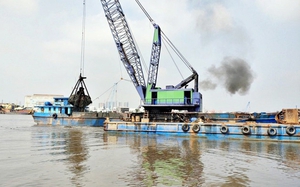Requirements concerning dredging, disposal and placement of dredged materials in Vietnam
Recently, the Government has issued regulations on management of dredging operations within seaport water and inland water areas, which include requirements concerning dredging, disposal, and placement of dredged materials in Vietnam.

Requirements concerning dredging, disposal and placement of dredged materials in Vietnam (Internet image)
Regarding this matter, LawNet would like to answer as follows:
On May 20, 2024, the Government issued Decree 57/2024/ND-CP on management of dredging operations within seaport water and inland water areas in Vietnam.
Requirements concerning dredging, disposal and placement of dredged materials in Vietnam as of July 5, 2024
According to Article 5 of Decree 57/2024/ND-CP, the requirements concerning dredging, disposal and placement of dredged materials in Vietnam are as follows:
- Before carrying out dredging operations, the project owners shall notify their action plans (including such information as schedule, duration, progress, scale, type and quantity of dredging equipment, dredging forms, onshore or offshore disposal sites) to specialized regulatory authorities (e.g. regional maritime administrations and regional inland waterway administrations) and provincial People’s Committees where dredging projects are located, and installing project signboards near project sites. The project signboard must give information about the approval-granting authority, project owners, investors, project management units, supervisors, contractors, project scale, schedule, commencement time, completion time, funding sources, project implementation forms, onshore or offshore disposal sites.
- Owners, stakeholders and investors in projects for dredging of navigable channels within seaport water and inland water areas shall be responsible for supervising dredging, disposal and placement of dredged materials from the beginning to the end of dredging operations, including but not limited to the following tasks:
+ Conducting the close supervision of dedicated dredging equipment in order to ensure dredging operations are carried out within the boundaries of the approved projects and in compliance with project designs;
+ Conducting the strict supervision of the routes of carriers designed for transport and disposal of dredged materials offshore, disposal of dredged materials at locations which are approved by authorized licensing authorities;
+ the management of dredging surveillance system data in order to meet demands of management, examination, surveillance;
+ Conducting the supervision of dredging operations to ensure conformance to safety, environmental protection and other requirements in accordance with legislative regulations in force.
- Dredging equipment, dredged material carriers must be equipped with dredging surveillance equipment and comply with all operational requirements as stipulated by law.
- Requirements of dredging surveillance systems:
+ Dredging surveillance equipment installed on dredging equipment: must include AIS devices in order to provide information about positions of dredging equipment via AIS shore station to AIS data center;
+ Dredging surveillance equipment installed on carriers intended for transport and disposal of dredged materials must include AIS devices in order to provide information about courses, routes and journeys of these carriers via AIS shore station to AIS data center; cameras providing images of dredged material holds upon receipt of dredged materials along the route to dumping sites, and from the beginning to the end of disposal of dredged materials at the prescribed locations;
+ Dredging surveillance equipment must be fixed in the appropriate position on dredging equipment and dredged material carriers in order to facilitate recording of all necessary data and images, and must be designed with measures for preventing and controlling any impact that may falsify data (e.g., security lead or seal attachments, etc.), and ensure they work under continuous and stable conditions during the project execution period.
+ The cost of installing surveillance equipment on dredging equipment and carriers shall be borne by the contractor. The AIS shore station to AIS data center shall be either invested in or outsourced by the project owner or investor.
Nguyen Ngoc Que Anh
- Key word:
- dredged materials
- Vietnam
- Guidelines for maintenance and renovation of villas in Ho Chi Minh City
- Guidelines for maintenance and renovation of villas in Ho Chi Minh City
- Resolution 190: Principles for addressing certain issues related to the organization and arrangement of state apparatus in Vietnam
- Guidance on identifying cases of inaccurate or non-operational electricity meters in Vietnam
- Official Telegram 16: Urgent requirement to allocate the entire state budget investment plan in 2025 in Vietnam
- Prime Minister of Vietnam directs to accelerate allocation and disbursement of public investment capital in 2025 in Vietnam
-

- Procedures for high school admission in Vietnam
- 14:25, 21/02/2025
-

- Resolution 190: Principles for addressing certain ...
- 11:30, 21/02/2025
-

- Guidance on identifying cases of inaccurate or ...
- 11:00, 21/02/2025
-

- Official Telegram 16: Urgent requirement to allocate ...
- 08:00, 21/02/2025
-

- Circular 04/2025 stipulating on the quality assessment ...
- 18:41, 20/02/2025
-

- Guidelines for maintenance and renovation of villas ...
- 14:30, 21/02/2025
-

- Guidelines for maintenance and renovation of villas ...
- 14:30, 21/02/2025
-

- Procedures for high school admission in Vietnam
- 14:25, 21/02/2025
-

- Resolution 190: Principles for addressing certain ...
- 11:30, 21/02/2025
-

- Guidance on identifying cases of inaccurate or ...
- 11:00, 21/02/2025
 Article table of contents
Article table of contents
